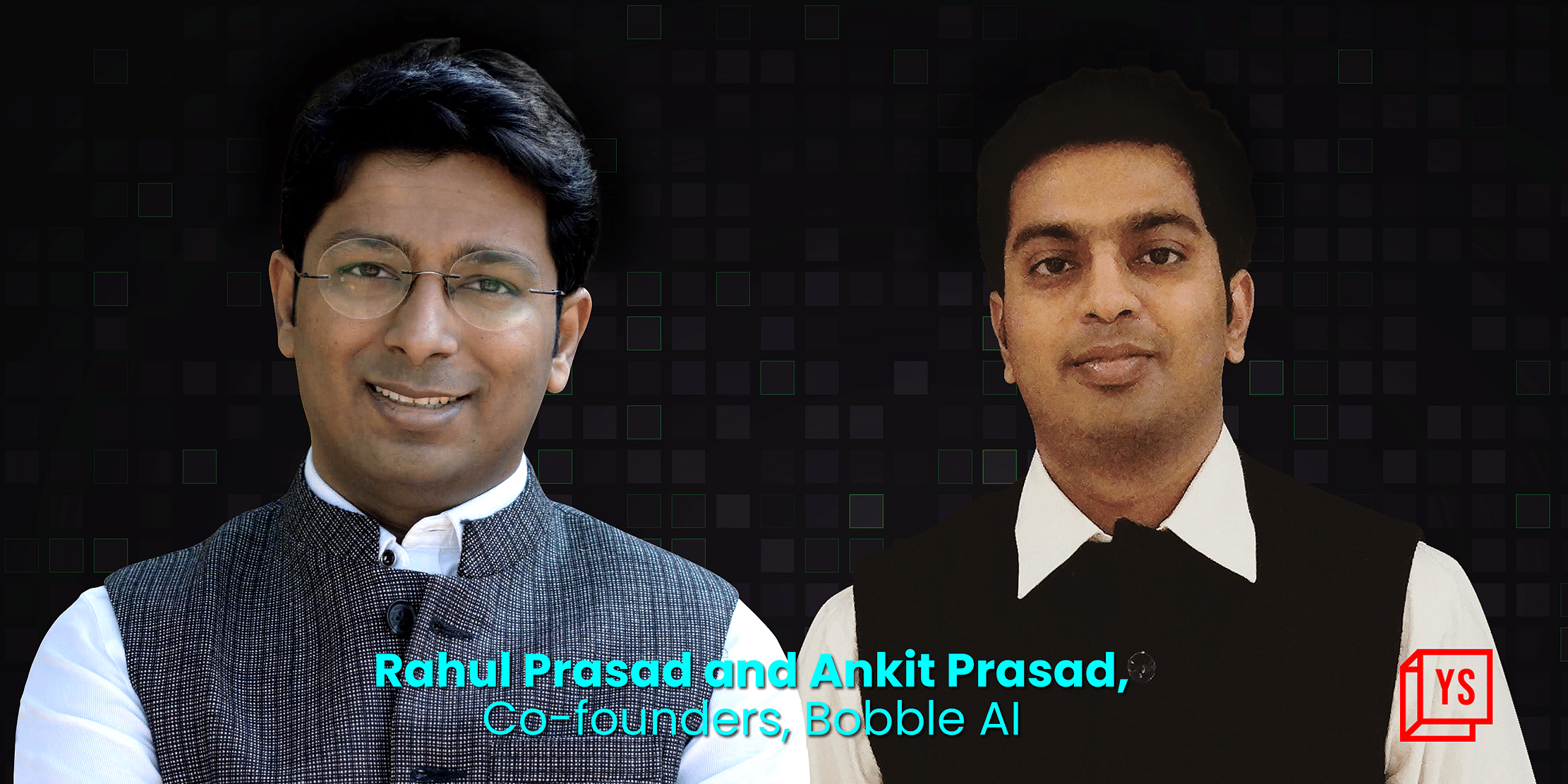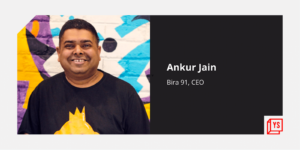The jury may still be out on the evolution of ecommerce in the future, but Bobble AI has already taken its next bet: conversational commerce.
At the core of this new offering is its main product—a keyboard used by more than 83 million users.
AI-powered startup offers Indic keyboards that allow users to type in Indian languages, supporting over 120 languages and dialects, including Hindi, Bangla, Marathi, Malayalam, Tamil, and Punjabi.
With a growing user base, Bobble AI saw the opportunity to extend its offering to a super keyboard.
On tapping the ‘Super Assist’ icon, the Bobble keyboard turns into a super keyboard that offers suggestions when it comes to frequently-used services such as payments, shopping, or travel, Ankit Prasad, Co-founder, tells YourStory.
For a user, this would mean being able to book a cab or order a product using Bobble’s keyboard. The app, depending on the conversation, suggests and leads to the individual app, and lets the user choose a product or book a cab with a tap on the keyboard.
“We are integrating these services inside the real estate of a keyboard—our platform—and making them conversational for consumption,” Ankit says.
Conversational commerce is an extension of social commerce, which is used by big tech players like Facebook, Instagram, and Twitter as vehicles to promote and sell products and services.
Until now, Bobble was personalising conversations with its artificial intelligence-based suggestions, GIFs, stickers, emojis among other things.
Now, going beyond intelligent recommendations, it wants people to use its keyboard to indulge in ecommerce transactions, which recommends on the keyboard. Bobble earns a commission for every transaction directed through its keyboard.
Launched a few months back, Bobble’s keyboard has offerings from five partners in sectors such as direct-to-consumer, merchandising, commute, news, and horoscope.
One of its partners is Uber. The company did not disclose other names.
Tapping a conversation platform for ecommerce
Ankit, an IIT dropout, is the startup’s CEO and his elder brother, Rahul Prasad, is Co-founder and CTO. Previously, they co-founded networking platform Touchtalent.
Bobble envisions itself as a conversation media platform on top of the keyboard offering, similar to how Instagram is a social media platform with a camera as the base. It wants users to look at the keyboard not for mere utility but as a platform that they use for commerce as well.
Why, though?
Ankit says a lot of these ideas get generated during conversations.
Since it started in 2015, Bobble has developed technology that understands the intent and context of conversations, and gives suggestions in real-time.
“The thesis is that a lot of intents get generated during conversations made on WhatsApp, Telegram, and Instagram. These conversations are leading to hundreds of intents for a particular consumer,” Ankit says.
The question then was one: “Can we proactively serve those intents through a third-party service integration within (the keyboard)?”
With WhatsApp, Telegram, Facebook, and Instagram growing in users, messaging has become one of the primary ways to communicate with each other.
India is WhatsApp’s leading market and has over 450 million users. Facebook has about 240 million users in the country. The familiarity with the user experience in these apps makes it easier for consumers to watch videos or read news.
Bobble wants to capitalise on these users and their behaviour.
“Our idea of commerce is through the keyboard within the same interface. Keyboard as-a-platform suitable in picking up real-time intent, on the basis of what the user is acting on in the smartphone and giving personalised suggestions,” Ankit says.
Bobble’s keyboard can closely capture this intent and is in the “right position” to address these intents. This, it says, will also reduce the need to use multiple apps for a single service, which Bobble plans to aggregate and offer through its keyboard.
The total spend over conversational commerce channels will reach $290 billion by 2025, rising from $41 billion in 2021, according to a study from Juniper Research.
Bobble AI is backed by investors including SAIF Partners, Xiaomi Inc., and Affle India.
Generating insights and intelligence
A part of the reason the Gurugram-based startup is able to promise this offering is because of the engagement metrics and machine learning algorithms it has developed over the years.
When it started, Bobble enabled users to turn their selfies into caricature stickers. Through the years, it evolved into a holistic content and keyboard app.
Once downloaded, the Bobble keyboard is used every time a user wants to type something. Bobble captures user data as intent to do an activity and uses this to offer text suggestions or personalised emoji or sticker suggestions. At least 20 million people are using its platform at any time during the day, the company says.
It processes this user data to generate signals and insights, and earns from it. It provides market intelligence to help its clients understand the industry or competition. It also uses data to provide predictive audience cohorts to particular companies to help them advertise and improve reach.
“We haven’t consented to first-party data; we are GDPR-compliant. And we use this data to generate value for brands in an aggregated anonymised manner,” Ankit says.
Last year, Bobble launched a conversational media marketing offering, which allows brands to leverage messaging platforms and market themselves when consumers are talking about things such as pizzas, cab rides, and more. This is done through branded stickers, GIFs, memes, or emojis.
Here, users are “sharing content and that sharing behaviour itself is getting monetised”, Ankit adds.
Ankit says both of these are ‘matured’ and growing. The startup has more than 50 brands, including Cadbury, Starbucks, and Patanjali, as its clients.
Bobble claims more than 70 billion messages, with 10 billion emojis and 700 million GIFs and stickers, are exchanged on a daily basis through its keyboards.
The company has a high user engagement and retention ratio with daily to monthly active user ratio of 78%. Its 90-day retention rate is about 75%.
“The vision was there from the beginning, but we never worked upon the commerce part of it until this quarter,” Ankit says. “Because for this model to be successful, first we needed a great product and a large user base, which is highly engaged and retained.”
“It’s the best time because conversational AI has also picked up, and brands have got some taste of bots,” he adds.
What’s next?
Bobble reaches its audience through marketing campaigns. Since 2019, the company’s total users have grown over 1,000%. This has been driven by the pandemic, addition of new internet users, and a shift in behaviour towards text-based conversations.
“When people spend most of their time at home, they spend more time on smartphones and therefore more time on conversations, because there is a lack of physical conversation,”
The company tested and launched the conversational offering in April and plans many more services in the coming months, Ankit says.
About 4-5% of its users come from Indonesia, where it aims to launch this offering next, as and when it is able to grow the user base.
In other regions where it has users, such as the Middle East, North Africa, and Europe, it is enabling conversational commerce players by licensing its technology.
Bobble’s team has grown to a team of 250 people.
Conversational commerce is a fast-growing segment for the company, so much so that it has been the largest–about 40%–contributor to its revenue segment, as of last month.
The data-as-a-service model, which historically added to the largest part of revenue, has come down to 25% from more than 50%.
Branded media contributes to about 15% of the revenue. The rest of it comes from licensing the patented language and keyboard technology to businesses, including dating apps or chatbots.
In FY 2022, Bobble AI reported a revenue of about $2.8 million (Rs 18 crore). For the next year, it aims to reach $15 million (about Rs 119 crore).
Though not profitable yet, the plan is to scale further, and increase expenses as revenue grows.
The company competes with the likes of Google’s Gboard and Microsoft SwiftKey keyboard in terms of product, but differentiates by offering localised content. Considering its revenue streams, it competes with third-party data aggregators; in content, the likes of Snapchat and Bitmoji have similar offerings.
As Bobble aims to increase its user base and engagement level, the company is also preparing for an Initial Public Offering (IPO). This includes building its management team and achieving corporate governance levels. It plans to launch an IPO in India in the next two to three years, depending on “when the market is favourable”.










